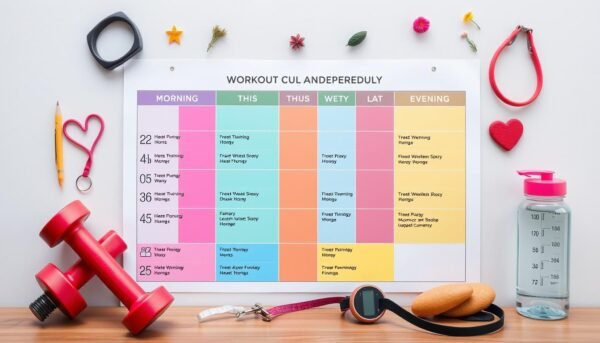Looking in the mirror, I saw the truth. The extra weight and flab around my midsection had grown. At 52, my metabolism was slowing, and my body wasn’t responding to old workouts. But then, I found weight training, and it changed everything for me.
They say losing weight gets harder with age. But I’m here to say it’s not impossible. Weight training can be a game-changer for those over 50 wanting to lose fat and transform their bodies. It’s about more than just losing weight; it’s about getting healthy, strong, and confident again.
In this guide, I’ll explain why weight training is key for fat loss after 50. I’ll give you a step-by-step plan to start your fitness journey. Whether you’re new to weightlifting or looking to change your routine, this guide will help. Get ready for a journey that will change your body, mind, and life.
Why Weight Training is Essential for Fat Loss After 50

As we get older, our bodies change a lot. We lose muscle mass, which slows down our metabolism. This makes it harder to lose fat.
Understanding Age-Related Muscle Loss
Sarcopenia is the term for muscle loss with age. It makes it harder to burn calories. Weight training helps keep muscle and a healthy metabolism.
The Role of Metabolism in Weight Loss
Metabolism is key for losing weight. It slows down with age. Weight training boosts metabolism and helps burn calories, even when resting.
Hormonal Changes and Their Impact
Hormonal changes, like lower estrogen and testosterone, can cause weight gain. Weight training helps manage these changes and keeps metabolism healthy.
Adding weight training to your routine is vital for losing fat after 50. It helps maintain muscle, boosts metabolism, and manages hormonal changes. Be consistent and patient, as results take time but are worth it.
The Science Behind Weight Training and Fat Burning

Weight training is a great way to lose weight. It works by changing your muscle mass and metabolism. Training with weights helps you build lean muscle. This boosts your metabolism and helps burn fat.
Weight training increases your muscle mass. More muscle means you burn more calories, even when you’re not moving. This is because muscle needs more energy than fat. So, as you build muscle, your body burns more calories, making it easier to lose fat.
Also, weight training keeps burning calories after you finish working out. This is called excess post-exercise oxygen consumption (EPOC). It raises your metabolism for hours, helping you burn calories even when you’re not moving. This makes weight training a great way to burn fat.
To get the most from weight training, focus on building muscle. Beginners can see muscle gains in 3-4 weeks with regular workouts. But, as you get more experienced, it takes more effort to see gains.
- Weight training boosts metabolism by increasing muscle mass, which burns more calories even at rest
- The EPOC effect of weight training continues to burn calories for hours after your workout
- Beginners can see faster muscle gains, while experienced individuals require more effort for less growth
- Combine weight training with a calorie deficit and a diet focused on nutrient-dense foods to support fat loss
Understanding how weight training works can help you reach your weight loss goals. Remember, it takes time and effort to build muscle and lose fat. Stay consistent and patient.
Getting Started: Basic Equipment and Setup

Starting a fitness journey at home is exciting and affordable. You need a well-equipped home gym for your workouts. We’ll cover the basics to set up your fitness space.
Essential Home Gym Equipment
Having the right equipment is key for a good home gym. Start with dumbbells in different weights. Also, get resistance bands for extra strength without big machines.
A stability ball is great for your core, balance, and flexibility. It fits well with your workout plan.
Gym Membership vs Home Workouts
Choosing between a gym and a home gym depends on what you prefer and can afford. Gym memberships cost about $58 a month, or $6,960 in 10 years. Home gym equipment costs around $1,300, saving money in the long run.
If you have space and can afford it, a home gym is convenient. But, if you like the gym atmosphere, a membership might be better.
Safety Considerations for Beginners
Focus on safety as you start your fitness journey. Check if you can do basic moves like hanging, planking, and squatting without weights. Start with bodyweight exercises and add weights later, keeping proper form.
Getting a personal trainer for a few sessions is a good idea. They help you do exercises right and safely. This prevents injuries and makes your workouts more effective.
How to lose 50 pounds Through Strategic Weight Training

Are you trying to lose 50 pounds? Strategic weight training can help. It combines resistance exercises with a calorie-deficit diet for fat loss success.
Addie Gibson lost 50 pounds in six months. She did 3-4 weight training sessions a week. The Mayo Clinic says 30 minutes of activity daily helps with weight loss.
Focus on compound exercises to burn more calories. Increase the weight or reps to challenge your muscles. This helps build strength and lose weight.
Add cardio like brisk walking or HIIT to your routine. This mix of strength and cardio creates a calorie deficit. It leads to steady weight loss.
Eat a high-protein diet to support muscle growth. Include lean proteins, fruits, veggies, and healthy fats in your meals. Drinking at least a gallon of water a day helps control hunger and boosts metabolism.
Stay consistent with your workout and diet plan. Aim to lose 1-2 pounds a week. Losing 50 pounds in 6 months is possible with the right strategy.
Combine strength training, a calorie-deficit diet, and healthy habits for a weight loss journey. Stay dedicated and watch the pounds disappear.
Creating a Sustainable Weekly Workout Schedule

To lose 50 pounds, you need a good exercise plan. It should be both effective and easy to keep up with. A weekly schedule that mixes strength training, cardio, and rest is key.
Balancing Rest and Recovery
For a exercise routine that works, aim for 2-3 strength training days a week. Mix these with cardio days. This balance helps your muscles recover and get stronger. It also improves your heart health.
Combining Cardio with Weight Training
Do at least 150 minutes of moderate cardio each week. This can be brisk walks or cycling. You can also add outdoor walks on non-training days. Always listen to your body and adjust the intensity to keep it sustainable.
Progressive Overload Principles
- Slowly increase the weight, reps, or sets in your workouts. This challenges your muscles and helps you progress.
- Track your weights and reps. Try to beat your previous numbers in each workout.
- Progressive overload is crucial for building muscle and losing fat.
By using these tips, you’ll make a workout plan that lasts. Be patient, listen to your body, and adjust as needed. This way, your workouts will stay challenging but still doable.
Fundamental Weight Training Exercises for Beginners

If you’re over 50 and want to lose weight, weight training can help a lot. As a beginner, it’s important to learn the basics first. Here are some key exercises to start with and boost your fat loss.
- Goblet Squats: Hold a dumbbell or kettlebell at chest level. Lower your hips like you’re sitting in a chair. Keep your core tight and chest up, then push back up.
- Bent-Over Rows: Stand with feet shoulder-width apart and knees slightly bent. Bend forward at the hips. Hold a dumbbell with an overhand grip and pull it up to your chest, squeezing your shoulder blade.
- Lateral Lunges: Step out to the side with one leg. Keep your torso straight. Lower your hips, then push back up. Do the same on the other side.
- Renegade Rows: Start in a high plank with hands on dumbbells. Keep your core stable. Row one dumbbell up, then switch sides.
- Russian Twists: Sit on the floor with knees bent and feet lifted. Hold a weight at your chest. Twist your torso from side to side, tapping the weight to the floor.
Begin with bodyweight exercises to learn the right form. Do 3 sets of 8-12 reps for each exercise. Focus on controlled movements and proper technique. This routine will help you get stronger, more stable, and burn fat.
Remember, being consistent is crucial. Stick to this weight training program, and you’ll see great changes in your fitness.
Proper Form and Technique Guidelines

Keeping proper form and technique is key in your exercise routine and fitness journey. Bad form can make your workouts less effective and raise injury risks. As you start weight training, learning the basics is vital for good results and safety.
Common Mistakes to Avoid
Many people lift with momentum instead of muscle power. This makes exercises less effective and strains joints. Not using your core can also hurt your balance and stability.
Breathing Patterns During Exercise
Right breathing is crucial for weight training. Breathe out when lifting and in when lowering. This helps you lift stronger and stay stable.
Range of Motion Considerations
Also, watch your exercise range. Use a full range that feels right for you. If you feel pain, stop and check your form or get help from a fitness expert.
By focusing on form, breathing, and range, you’ll boost your exercise routine and cut injury risks. This sets you up for a lasting and successful fitness transformation.
Nutrition Strategies to Support Weight Training

Reaching your weight loss goals needs more than just gym time. Eating right is key for muscle growth, recovery, and fat loss. Here are some diet tips to help you succeed in your weight training.
Consume Adequate Protein: Eat 0.73 grams of protein for every pound of your body weight. Focus on lean proteins like eggs, chicken, fish, tofu, and lentils. They are the base of your meals.
Focus on Whole Foods: Eat more whole, unprocessed foods. Include complex carbs, healthy fats, and lots of fruits and veggies. These foods give you the energy and nutrients you need for workouts and recovery.
Hydrate Consistently: Drinking water is vital for health and workout performance. Drink water all day and more before and after workouts.
Time Your Meals: Eat meals and snacks at the right times to boost energy and aid recovery. Try carbs before working out and protein after. See what works best for you.
Avoid Extreme Calorie Restriction: Cutting calories is good for losing fat, but too much can harm muscle growth and slow your metabolism. Aim for a 500-1,000 calorie deficit to lose weight healthily.
| Dietary Changes | Portion Control | Healthy Lifestyle |
|---|---|---|
|
|
|
By focusing on nutrition, you can better support your weight training. This will help you lose fat and live a healthier life.
Tracking Progress and Making Adjustments
On your weight loss journey, tracking more than just the scale is key. The scale shows numbers, but it’s not everything. By looking at different metrics, you get a full picture of your progress. This helps you make changes when needed.
Measuring Success Beyond the Scale
Take body measurements like waist, hips, and thighs. Progress photos show your changes well. Notice how your clothes fit and your energy levels. These signs of progress are as important as the scale.
When to Modify Your Program
Check your program every 4-6 weeks. If exercises are too easy, add more weight or reps. If progress slows, try new exercises, adjust your diet, or get expert advice. Being open to change is crucial for lasting weight loss.
This post may contain affiliate links which means I may receive a commission for purchases made through links. I will only recommend products that I have personally used! Learn more on my Private Policy page.